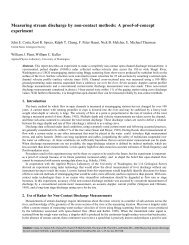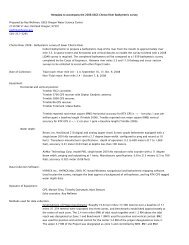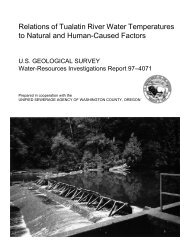Precipitation-Runoff and Streamflow-Routing Models for the ...
Precipitation-Runoff and Streamflow-Routing Models for the ...
Precipitation-Runoff and Streamflow-Routing Models for the ...
- No tags were found...
Create successful ePaper yourself
Turn your PDF publications into a flip-book with our unique Google optimized e-Paper software.
network-routing models where available, <strong>and</strong>simulated streamflows from runoff model resultswere used <strong>for</strong> ungaged areas. Absolute error <strong>for</strong><strong>the</strong> network-routing models ranged from about 21percent <strong>for</strong> <strong>the</strong> Molalla River model, <strong>for</strong> which 70percent of <strong>the</strong> subbasin was ungaged, to about 4percent <strong>for</strong> <strong>the</strong> Willamette main-stem model(Albany to Salem), <strong>for</strong> which only 9 percent of<strong>the</strong> subbasin was ungaged.With an input of current streamflow,precipitation, <strong>and</strong> air temperature data <strong>the</strong>combined runoff <strong>and</strong> routing models can providecurrent estimates of streamflow at almost 500locations on <strong>the</strong> main stem <strong>and</strong> major tributariesof <strong>the</strong> Willamette River with a high degree ofaccuracy. Relative contributions of surface runoff,subsurface flow, <strong>and</strong> ground-water flow can beassessed <strong>for</strong> 1 to 10 HRU classes in each of 253subbasins identified <strong>for</strong> precipitation-runoffmodeling. Model outputs were used with a waterqualitymodel to simulate <strong>the</strong> movement of dye in<strong>the</strong> Pudding River as an example application in<strong>the</strong> Willamette River Basin.INTRODUCTIONIn 1991, <strong>the</strong> U.S. Geological Survey (USGS)began a cooperative program with <strong>the</strong> Oregon Departmentof Environmental Quality (ODEQ) to studywater quality in <strong>the</strong> main stem <strong>and</strong> major tributaries of<strong>the</strong> Willamette River. The program was part of a largerstudy that included participation by ODEQ, USGS, aprivate consultant, <strong>and</strong> Oregon State University. Thelarger ODEQ study (Tetra Tech, Inc., 1993) isintended to provide in<strong>for</strong>mation on dissolved oxygen,nutrients, algae, toxics, bacteria, point <strong>and</strong> nonpointpollution sources, sediments, river ecology, <strong>and</strong> riverflow. The in<strong>for</strong>mation from <strong>the</strong> ODEQ study, in turn,will provide a foundation <strong>for</strong> future long-term work<strong>and</strong> management decisions on water-quality issues in<strong>the</strong> basin.The USGS cooperative program with ODEQconsisted of three parts: (1) a streamflow simulationusing precipitation-runoff <strong>and</strong> streamflow-routingmodels, (2) an analysis of sediment transport (Laenen,1995), <strong>and</strong> (3) a reconnaissance-level determination ofcontaminants. This report describes <strong>the</strong> developmentof models <strong>for</strong> streamflow simulation. The existingmodels have not been fully calibrated <strong>for</strong> use in waterqualityassessment; however, <strong>the</strong>y can be used to supply<strong>the</strong> required hydrologic inputs <strong>for</strong> future waterqualitymodeling.The USGS program was also designed to complement<strong>the</strong> USGS Willamette National Water-QualityAssessment (NAWQA) study that began in fiscal year1993. The Willamette Basin is one of 60 basins in <strong>the</strong>Nation that will be studied by NAWQA. NAWQA isdesigned to describe <strong>the</strong> status of <strong>and</strong> trends in <strong>the</strong>Nation’s ground- <strong>and</strong> surface-water resources <strong>and</strong> toprovide a sound underst<strong>and</strong>ing of <strong>the</strong> natural <strong>and</strong>human factors that affect <strong>the</strong> quality of <strong>the</strong>se resources.The NAWQA intends to integrate in<strong>for</strong>mation at differentspatial scales—local, study unit, regional, <strong>and</strong>national—<strong>and</strong> will focus on water-quality conditionsthat affect large areas or are recurrent on <strong>the</strong> localscale.BackgroundA large quantity of streamflow data is available<strong>for</strong> <strong>the</strong> Willamette River Basin, <strong>and</strong> two previouslydeveloped streamflow-simulation models are regularlyused to simulate flows in <strong>the</strong> basin. Most streamflowrouting in <strong>the</strong> basin has been done by <strong>the</strong> NationalWea<strong>the</strong>r Service (NWS) <strong>and</strong> <strong>the</strong> U.S. Army Corps ofEngineers (USACE). The NWS uses <strong>the</strong> <strong>Streamflow</strong>Syn<strong>the</strong>sis <strong>and</strong> Reservoir Regulation (SSARR) model(U.S. Army Corps of Engineers, 1975) <strong>for</strong> flood predictionpurposes. The USACE primarily uses HydrologicEngineering Center—Fifth Model (HEC–5)(U.S. Army Corps of Engineers, 1982) <strong>for</strong> throughreservoirstreamflow routing <strong>and</strong> testing.The existing models are intended <strong>for</strong> flood routing<strong>and</strong> are satisfactory <strong>for</strong> this purpose, but <strong>the</strong>y areless satisfactory <strong>for</strong> water-quality applications. Theexisting models do not adequately define <strong>the</strong> complexhydrology of <strong>the</strong> basin or identify effects of humanactivities o<strong>the</strong>r than reservoir regulation, do not havehydraulic-flow equations, <strong>the</strong>y do not link precipitationrunoff to physical properties in <strong>the</strong> basin, <strong>and</strong> have notbeen calibrated to low-streamflow conditions becauselow-flow data are missing <strong>for</strong> critical locations.Current SSARR <strong>and</strong> HEC models provide veryusable high-flow simulations but cannot provide a conceptualunderst<strong>and</strong>ing of <strong>the</strong> physical flow system. Theprecipitation-runoff component of <strong>the</strong> SSARR modelsimulates <strong>the</strong> streamflow response to precipitation bymeans of simple equations that represent surface flow2







